Health Service Planning Report: Analyzing Health Service Interventions
VerifiedAdded on 2021/06/18
|11
|2954
|125
Report
AI Summary
This report provides an analysis of several studies related to health service planning. It examines the effectiveness of hospital-based care interventions for children with special healthcare needs, chronic disease management programs in remote Aboriginal communities, and core primary health care services in rural and remote Australia. The report also explores advance care planning in residential aged care facilities and the impact of patient empowerment programs on type 2 diabetes management. Key findings include improved outcomes from comprehensive care programs, the importance of regular screening for chronic diseases, the need for equitable access to primary health care services, the benefits of advance care planning, and the positive effects of patient empowerment programs on clinical outcomes and health service utilization. The report highlights the implications of these studies for healthcare providers and policymakers, while also acknowledging the limitations of each study and suggesting areas for further research.
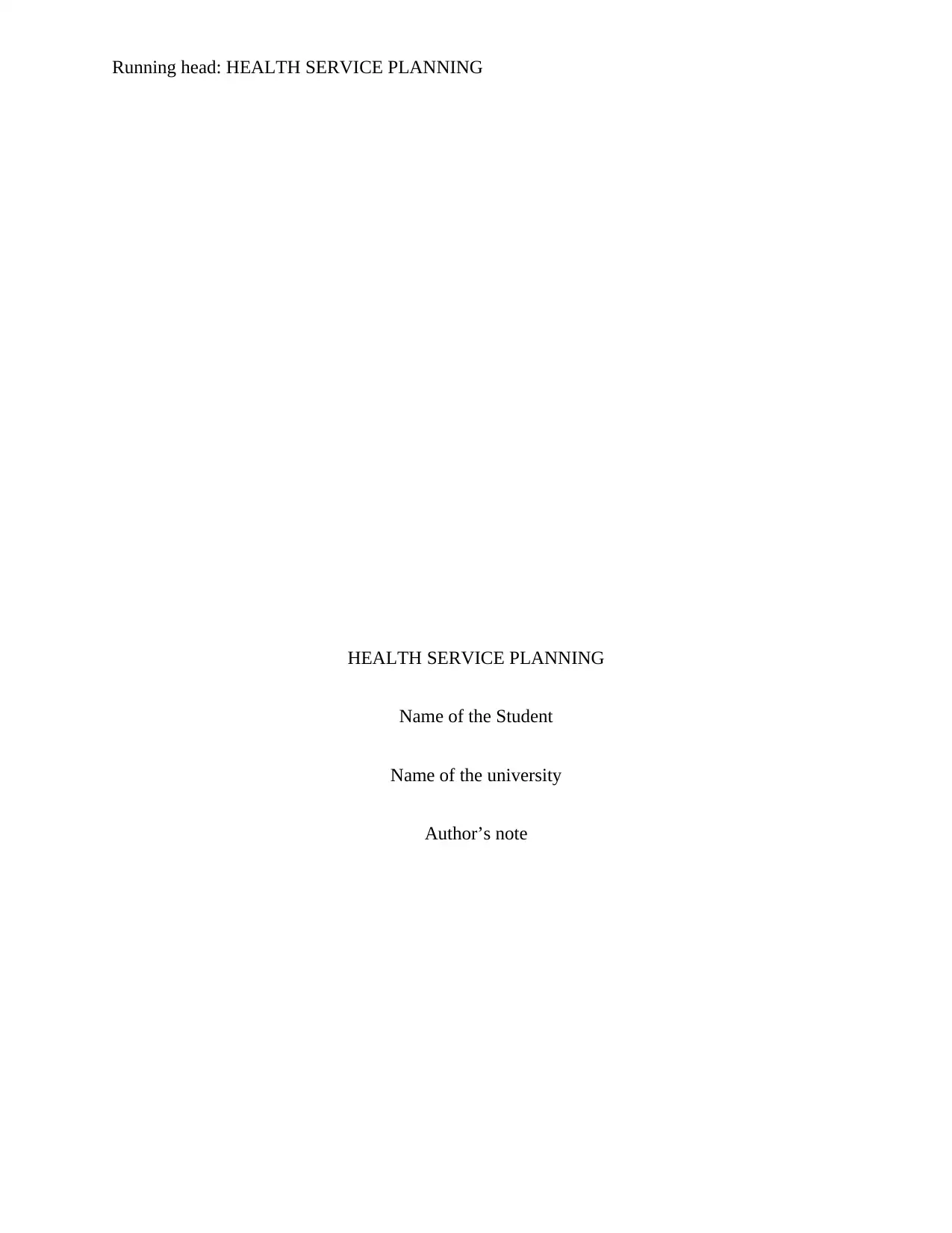
Running head: HEALTH SERVICE PLANNING
HEALTH SERVICE PLANNING
Name of the Student
Name of the university
Author’s note
HEALTH SERVICE PLANNING
Name of the Student
Name of the university
Author’s note
Paraphrase This Document
Need a fresh take? Get an instant paraphrase of this document with our AI Paraphraser

1HEALTH SERVICE PLANNING
Health service planning
1. Citation: Cohen, E., Jovcevska, V., Kuo, D.Z. and Mahant, S., 2011. Hospital-based
comprehensive care programs for children with special health care needs: a systematic
review. Archives of pediatrics & adolescent medicine, 165(6), pp.554-561.
Purpose of the work: The objective of this paper is to detect the effectiveness of the hospital
based care interventions in the improvement of the quality of care for the children with
disabilities or with special health care needs.
Summary: This paper is a systematic review that evaluated the comprehensive care programs for
the categorical and the non categorical population of the children was taken into consideration.
The paper has considered 33 unique programs of which 13 were RCTs. The improved outcomes
of the program included the efficacy of care, increased rate of family centeredness, timely care
and proper referrals.
Analysis:
The main intervention program that has been evaluated in this paper were mainly hospital based,
community based. 17 programs involved multidisciplinary teams, 15 programs were education
based providing awareness for a particular disease or health maintenance information, parenting
skills. The outcomes were then evaluated. (1% of the programs evaluated the effectiveness of the
health care provided to the patient. For example a program that focused n sickle cell anemia
found that the respondents in the intervention group faced less adverse crisis.
Health service planning
1. Citation: Cohen, E., Jovcevska, V., Kuo, D.Z. and Mahant, S., 2011. Hospital-based
comprehensive care programs for children with special health care needs: a systematic
review. Archives of pediatrics & adolescent medicine, 165(6), pp.554-561.
Purpose of the work: The objective of this paper is to detect the effectiveness of the hospital
based care interventions in the improvement of the quality of care for the children with
disabilities or with special health care needs.
Summary: This paper is a systematic review that evaluated the comprehensive care programs for
the categorical and the non categorical population of the children was taken into consideration.
The paper has considered 33 unique programs of which 13 were RCTs. The improved outcomes
of the program included the efficacy of care, increased rate of family centeredness, timely care
and proper referrals.
Analysis:
The main intervention program that has been evaluated in this paper were mainly hospital based,
community based. 17 programs involved multidisciplinary teams, 15 programs were education
based providing awareness for a particular disease or health maintenance information, parenting
skills. The outcomes were then evaluated. (1% of the programs evaluated the effectiveness of the
health care provided to the patient. For example a program that focused n sickle cell anemia
found that the respondents in the intervention group faced less adverse crisis.
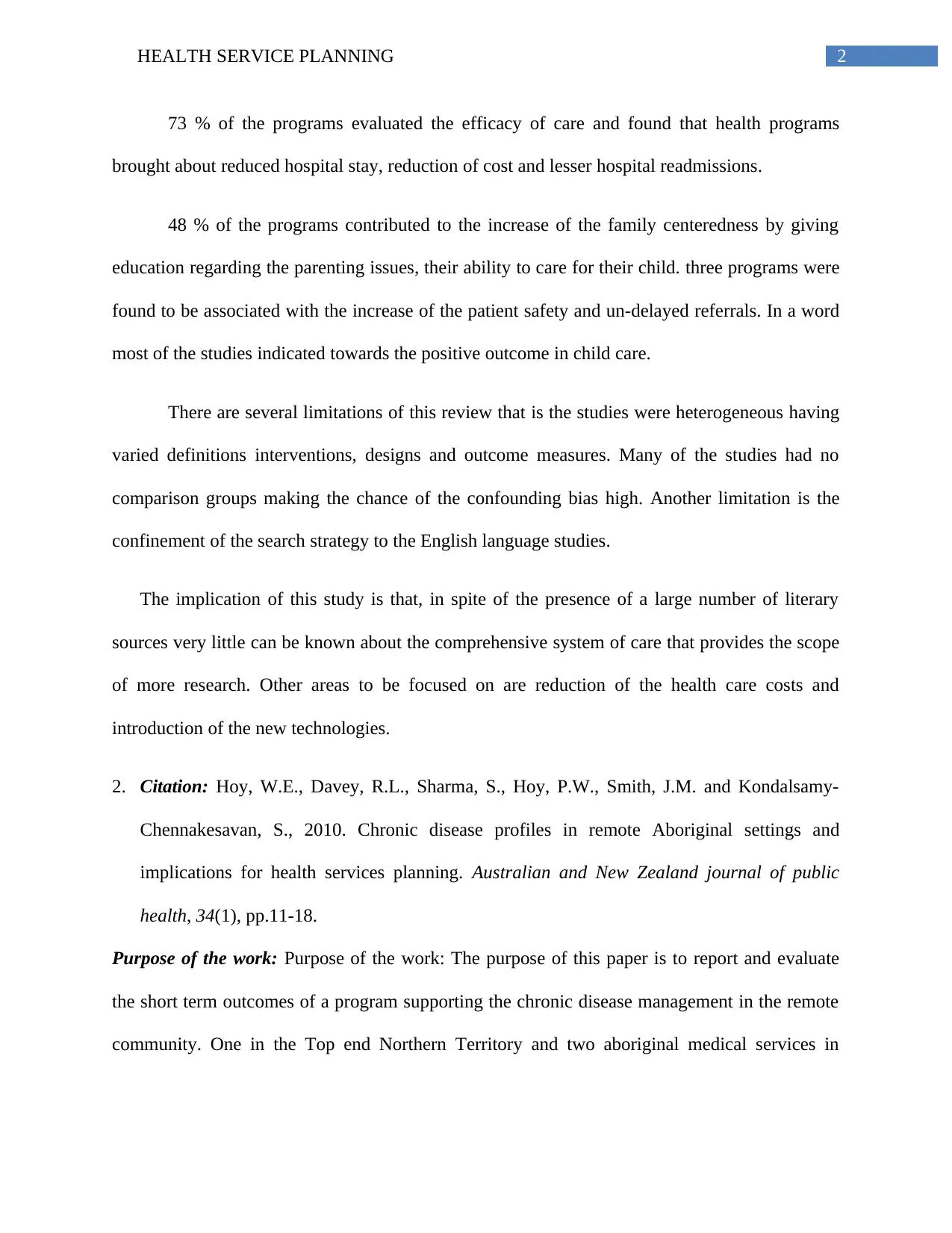
2HEALTH SERVICE PLANNING
73 % of the programs evaluated the efficacy of care and found that health programs
brought about reduced hospital stay, reduction of cost and lesser hospital readmissions.
48 % of the programs contributed to the increase of the family centeredness by giving
education regarding the parenting issues, their ability to care for their child. three programs were
found to be associated with the increase of the patient safety and un-delayed referrals. In a word
most of the studies indicated towards the positive outcome in child care.
There are several limitations of this review that is the studies were heterogeneous having
varied definitions interventions, designs and outcome measures. Many of the studies had no
comparison groups making the chance of the confounding bias high. Another limitation is the
confinement of the search strategy to the English language studies.
The implication of this study is that, in spite of the presence of a large number of literary
sources very little can be known about the comprehensive system of care that provides the scope
of more research. Other areas to be focused on are reduction of the health care costs and
introduction of the new technologies.
2. Citation: Hoy, W.E., Davey, R.L., Sharma, S., Hoy, P.W., Smith, J.M. and Kondalsamy‐
Chennakesavan, S., 2010. Chronic disease profiles in remote Aboriginal settings and
implications for health services planning. Australian and New Zealand journal of public
health, 34(1), pp.11-18.
Purpose of the work: Purpose of the work: The purpose of this paper is to report and evaluate
the short term outcomes of a program supporting the chronic disease management in the remote
community. One in the Top end Northern Territory and two aboriginal medical services in
73 % of the programs evaluated the efficacy of care and found that health programs
brought about reduced hospital stay, reduction of cost and lesser hospital readmissions.
48 % of the programs contributed to the increase of the family centeredness by giving
education regarding the parenting issues, their ability to care for their child. three programs were
found to be associated with the increase of the patient safety and un-delayed referrals. In a word
most of the studies indicated towards the positive outcome in child care.
There are several limitations of this review that is the studies were heterogeneous having
varied definitions interventions, designs and outcome measures. Many of the studies had no
comparison groups making the chance of the confounding bias high. Another limitation is the
confinement of the search strategy to the English language studies.
The implication of this study is that, in spite of the presence of a large number of literary
sources very little can be known about the comprehensive system of care that provides the scope
of more research. Other areas to be focused on are reduction of the health care costs and
introduction of the new technologies.
2. Citation: Hoy, W.E., Davey, R.L., Sharma, S., Hoy, P.W., Smith, J.M. and Kondalsamy‐
Chennakesavan, S., 2010. Chronic disease profiles in remote Aboriginal settings and
implications for health services planning. Australian and New Zealand journal of public
health, 34(1), pp.11-18.
Purpose of the work: Purpose of the work: The purpose of this paper is to report and evaluate
the short term outcomes of a program supporting the chronic disease management in the remote
community. One in the Top end Northern Territory and two aboriginal medical services in
⊘ This is a preview!⊘
Do you want full access?
Subscribe today to unlock all pages.

Trusted by 1+ million students worldwide
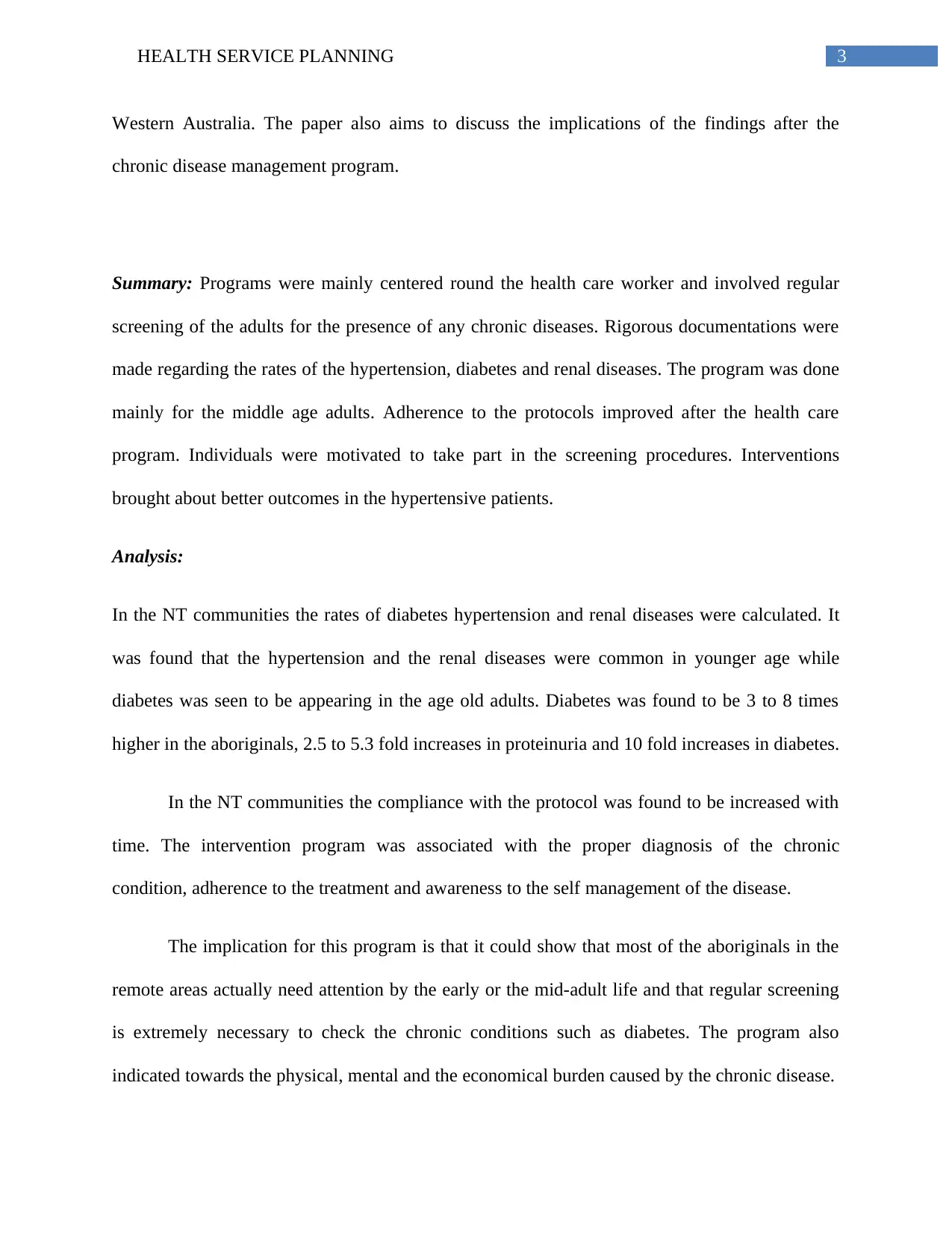
3HEALTH SERVICE PLANNING
Western Australia. The paper also aims to discuss the implications of the findings after the
chronic disease management program.
Summary: Programs were mainly centered round the health care worker and involved regular
screening of the adults for the presence of any chronic diseases. Rigorous documentations were
made regarding the rates of the hypertension, diabetes and renal diseases. The program was done
mainly for the middle age adults. Adherence to the protocols improved after the health care
program. Individuals were motivated to take part in the screening procedures. Interventions
brought about better outcomes in the hypertensive patients.
Analysis:
In the NT communities the rates of diabetes hypertension and renal diseases were calculated. It
was found that the hypertension and the renal diseases were common in younger age while
diabetes was seen to be appearing in the age old adults. Diabetes was found to be 3 to 8 times
higher in the aboriginals, 2.5 to 5.3 fold increases in proteinuria and 10 fold increases in diabetes.
In the NT communities the compliance with the protocol was found to be increased with
time. The intervention program was associated with the proper diagnosis of the chronic
condition, adherence to the treatment and awareness to the self management of the disease.
The implication for this program is that it could show that most of the aboriginals in the
remote areas actually need attention by the early or the mid-adult life and that regular screening
is extremely necessary to check the chronic conditions such as diabetes. The program also
indicated towards the physical, mental and the economical burden caused by the chronic disease.
Western Australia. The paper also aims to discuss the implications of the findings after the
chronic disease management program.
Summary: Programs were mainly centered round the health care worker and involved regular
screening of the adults for the presence of any chronic diseases. Rigorous documentations were
made regarding the rates of the hypertension, diabetes and renal diseases. The program was done
mainly for the middle age adults. Adherence to the protocols improved after the health care
program. Individuals were motivated to take part in the screening procedures. Interventions
brought about better outcomes in the hypertensive patients.
Analysis:
In the NT communities the rates of diabetes hypertension and renal diseases were calculated. It
was found that the hypertension and the renal diseases were common in younger age while
diabetes was seen to be appearing in the age old adults. Diabetes was found to be 3 to 8 times
higher in the aboriginals, 2.5 to 5.3 fold increases in proteinuria and 10 fold increases in diabetes.
In the NT communities the compliance with the protocol was found to be increased with
time. The intervention program was associated with the proper diagnosis of the chronic
condition, adherence to the treatment and awareness to the self management of the disease.
The implication for this program is that it could show that most of the aboriginals in the
remote areas actually need attention by the early or the mid-adult life and that regular screening
is extremely necessary to check the chronic conditions such as diabetes. The program also
indicated towards the physical, mental and the economical burden caused by the chronic disease.
Paraphrase This Document
Need a fresh take? Get an instant paraphrase of this document with our AI Paraphraser
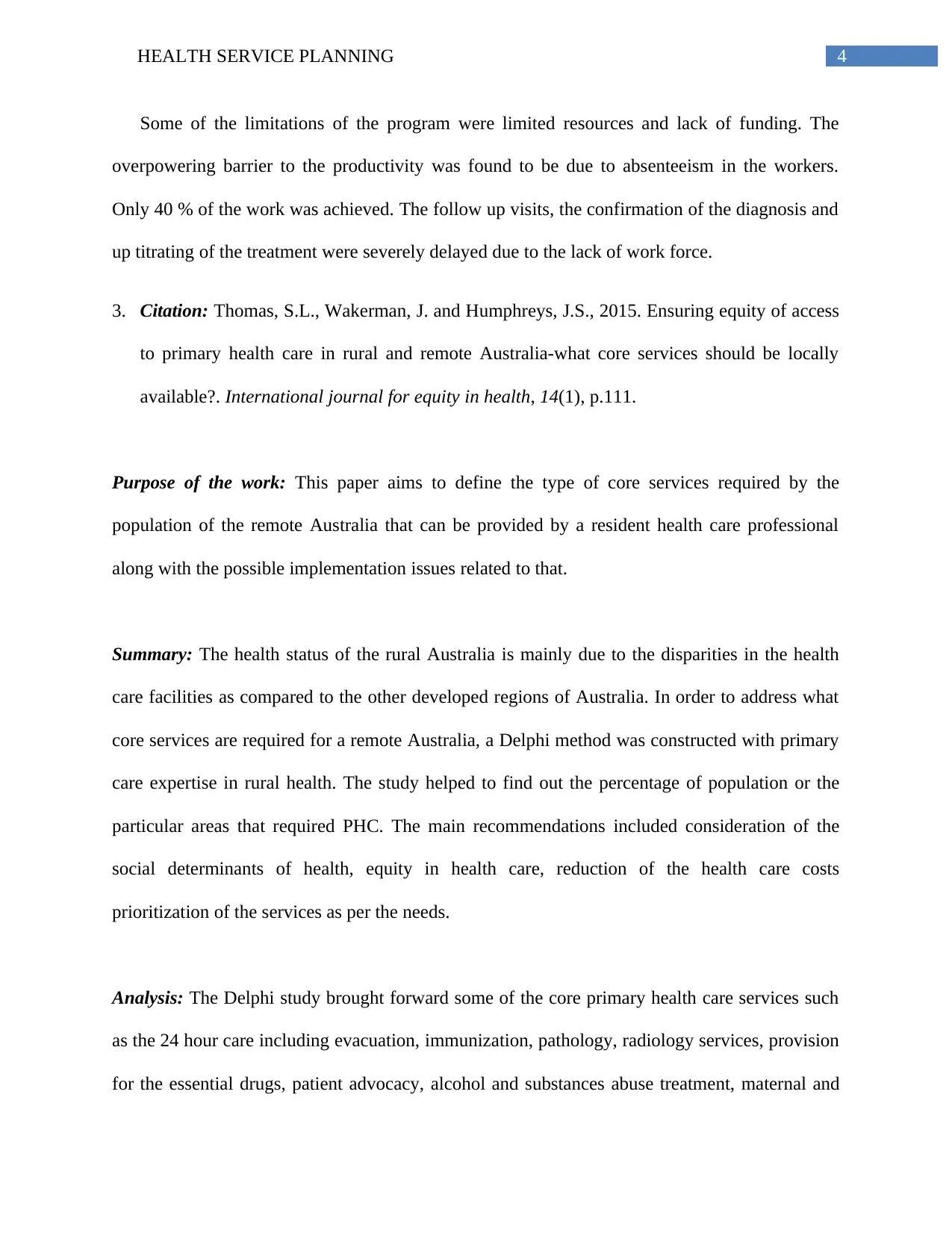
4HEALTH SERVICE PLANNING
Some of the limitations of the program were limited resources and lack of funding. The
overpowering barrier to the productivity was found to be due to absenteeism in the workers.
Only 40 % of the work was achieved. The follow up visits, the confirmation of the diagnosis and
up titrating of the treatment were severely delayed due to the lack of work force.
3. Citation: Thomas, S.L., Wakerman, J. and Humphreys, J.S., 2015. Ensuring equity of access
to primary health care in rural and remote Australia-what core services should be locally
available?. International journal for equity in health, 14(1), p.111.
Purpose of the work: This paper aims to define the type of core services required by the
population of the remote Australia that can be provided by a resident health care professional
along with the possible implementation issues related to that.
Summary: The health status of the rural Australia is mainly due to the disparities in the health
care facilities as compared to the other developed regions of Australia. In order to address what
core services are required for a remote Australia, a Delphi method was constructed with primary
care expertise in rural health. The study helped to find out the percentage of population or the
particular areas that required PHC. The main recommendations included consideration of the
social determinants of health, equity in health care, reduction of the health care costs
prioritization of the services as per the needs.
Analysis: The Delphi study brought forward some of the core primary health care services such
as the 24 hour care including evacuation, immunization, pathology, radiology services, provision
for the essential drugs, patient advocacy, alcohol and substances abuse treatment, maternal and
Some of the limitations of the program were limited resources and lack of funding. The
overpowering barrier to the productivity was found to be due to absenteeism in the workers.
Only 40 % of the work was achieved. The follow up visits, the confirmation of the diagnosis and
up titrating of the treatment were severely delayed due to the lack of work force.
3. Citation: Thomas, S.L., Wakerman, J. and Humphreys, J.S., 2015. Ensuring equity of access
to primary health care in rural and remote Australia-what core services should be locally
available?. International journal for equity in health, 14(1), p.111.
Purpose of the work: This paper aims to define the type of core services required by the
population of the remote Australia that can be provided by a resident health care professional
along with the possible implementation issues related to that.
Summary: The health status of the rural Australia is mainly due to the disparities in the health
care facilities as compared to the other developed regions of Australia. In order to address what
core services are required for a remote Australia, a Delphi method was constructed with primary
care expertise in rural health. The study helped to find out the percentage of population or the
particular areas that required PHC. The main recommendations included consideration of the
social determinants of health, equity in health care, reduction of the health care costs
prioritization of the services as per the needs.
Analysis: The Delphi study brought forward some of the core primary health care services such
as the 24 hour care including evacuation, immunization, pathology, radiology services, provision
for the essential drugs, patient advocacy, alcohol and substances abuse treatment, maternal and
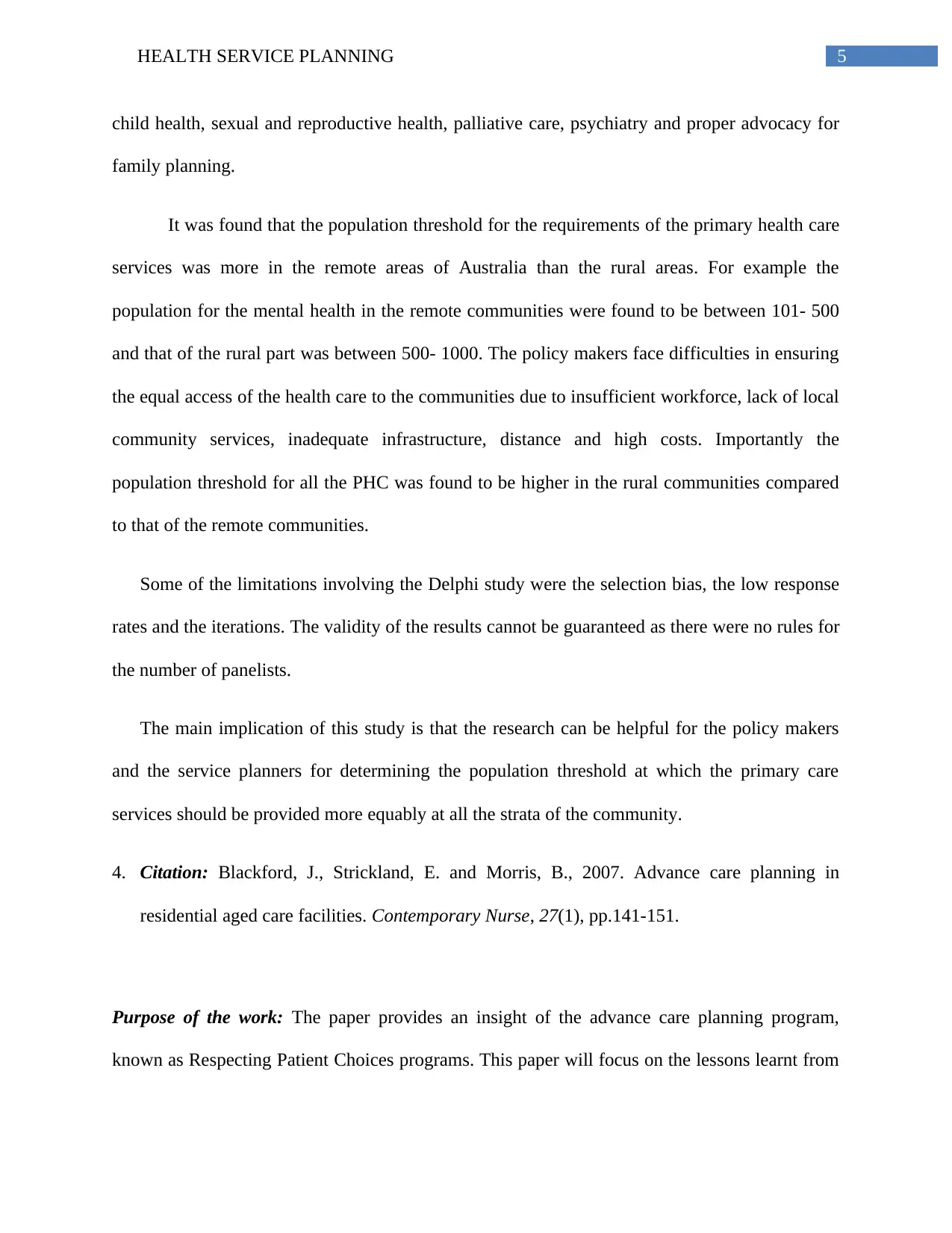
5HEALTH SERVICE PLANNING
child health, sexual and reproductive health, palliative care, psychiatry and proper advocacy for
family planning.
It was found that the population threshold for the requirements of the primary health care
services was more in the remote areas of Australia than the rural areas. For example the
population for the mental health in the remote communities were found to be between 101- 500
and that of the rural part was between 500- 1000. The policy makers face difficulties in ensuring
the equal access of the health care to the communities due to insufficient workforce, lack of local
community services, inadequate infrastructure, distance and high costs. Importantly the
population threshold for all the PHC was found to be higher in the rural communities compared
to that of the remote communities.
Some of the limitations involving the Delphi study were the selection bias, the low response
rates and the iterations. The validity of the results cannot be guaranteed as there were no rules for
the number of panelists.
The main implication of this study is that the research can be helpful for the policy makers
and the service planners for determining the population threshold at which the primary care
services should be provided more equably at all the strata of the community.
4. Citation: Blackford, J., Strickland, E. and Morris, B., 2007. Advance care planning in
residential aged care facilities. Contemporary Nurse, 27(1), pp.141-151.
Purpose of the work: The paper provides an insight of the advance care planning program,
known as Respecting Patient Choices programs. This paper will focus on the lessons learnt from
child health, sexual and reproductive health, palliative care, psychiatry and proper advocacy for
family planning.
It was found that the population threshold for the requirements of the primary health care
services was more in the remote areas of Australia than the rural areas. For example the
population for the mental health in the remote communities were found to be between 101- 500
and that of the rural part was between 500- 1000. The policy makers face difficulties in ensuring
the equal access of the health care to the communities due to insufficient workforce, lack of local
community services, inadequate infrastructure, distance and high costs. Importantly the
population threshold for all the PHC was found to be higher in the rural communities compared
to that of the remote communities.
Some of the limitations involving the Delphi study were the selection bias, the low response
rates and the iterations. The validity of the results cannot be guaranteed as there were no rules for
the number of panelists.
The main implication of this study is that the research can be helpful for the policy makers
and the service planners for determining the population threshold at which the primary care
services should be provided more equably at all the strata of the community.
4. Citation: Blackford, J., Strickland, E. and Morris, B., 2007. Advance care planning in
residential aged care facilities. Contemporary Nurse, 27(1), pp.141-151.
Purpose of the work: The paper provides an insight of the advance care planning program,
known as Respecting Patient Choices programs. This paper will focus on the lessons learnt from
⊘ This is a preview!⊘
Do you want full access?
Subscribe today to unlock all pages.

Trusted by 1+ million students worldwide
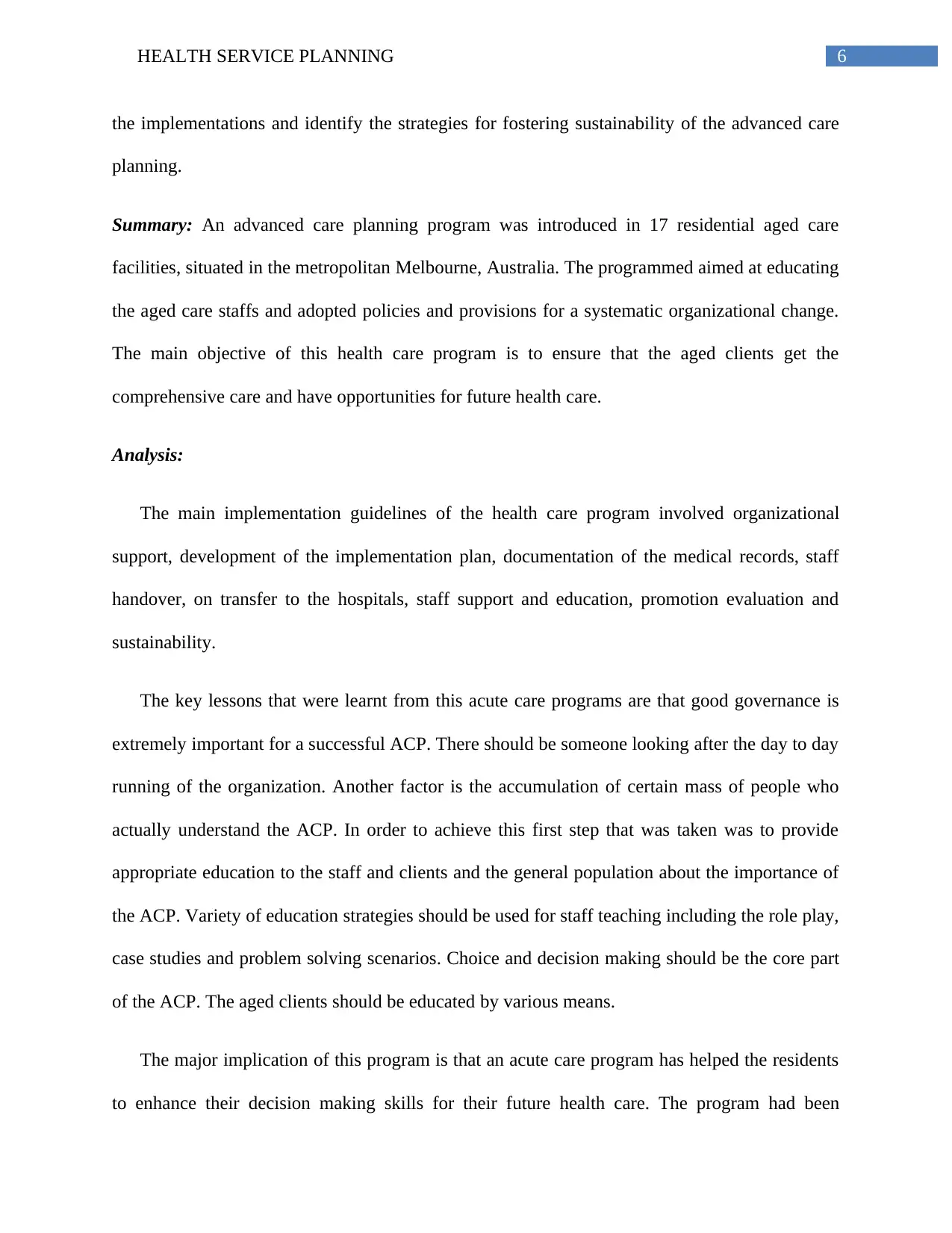
6HEALTH SERVICE PLANNING
the implementations and identify the strategies for fostering sustainability of the advanced care
planning.
Summary: An advanced care planning program was introduced in 17 residential aged care
facilities, situated in the metropolitan Melbourne, Australia. The programmed aimed at educating
the aged care staffs and adopted policies and provisions for a systematic organizational change.
The main objective of this health care program is to ensure that the aged clients get the
comprehensive care and have opportunities for future health care.
Analysis:
The main implementation guidelines of the health care program involved organizational
support, development of the implementation plan, documentation of the medical records, staff
handover, on transfer to the hospitals, staff support and education, promotion evaluation and
sustainability.
The key lessons that were learnt from this acute care programs are that good governance is
extremely important for a successful ACP. There should be someone looking after the day to day
running of the organization. Another factor is the accumulation of certain mass of people who
actually understand the ACP. In order to achieve this first step that was taken was to provide
appropriate education to the staff and clients and the general population about the importance of
the ACP. Variety of education strategies should be used for staff teaching including the role play,
case studies and problem solving scenarios. Choice and decision making should be the core part
of the ACP. The aged clients should be educated by various means.
The major implication of this program is that an acute care program has helped the residents
to enhance their decision making skills for their future health care. The program had been
the implementations and identify the strategies for fostering sustainability of the advanced care
planning.
Summary: An advanced care planning program was introduced in 17 residential aged care
facilities, situated in the metropolitan Melbourne, Australia. The programmed aimed at educating
the aged care staffs and adopted policies and provisions for a systematic organizational change.
The main objective of this health care program is to ensure that the aged clients get the
comprehensive care and have opportunities for future health care.
Analysis:
The main implementation guidelines of the health care program involved organizational
support, development of the implementation plan, documentation of the medical records, staff
handover, on transfer to the hospitals, staff support and education, promotion evaluation and
sustainability.
The key lessons that were learnt from this acute care programs are that good governance is
extremely important for a successful ACP. There should be someone looking after the day to day
running of the organization. Another factor is the accumulation of certain mass of people who
actually understand the ACP. In order to achieve this first step that was taken was to provide
appropriate education to the staff and clients and the general population about the importance of
the ACP. Variety of education strategies should be used for staff teaching including the role play,
case studies and problem solving scenarios. Choice and decision making should be the core part
of the ACP. The aged clients should be educated by various means.
The major implication of this program is that an acute care program has helped the residents
to enhance their decision making skills for their future health care. The program had been
Paraphrase This Document
Need a fresh take? Get an instant paraphrase of this document with our AI Paraphraser
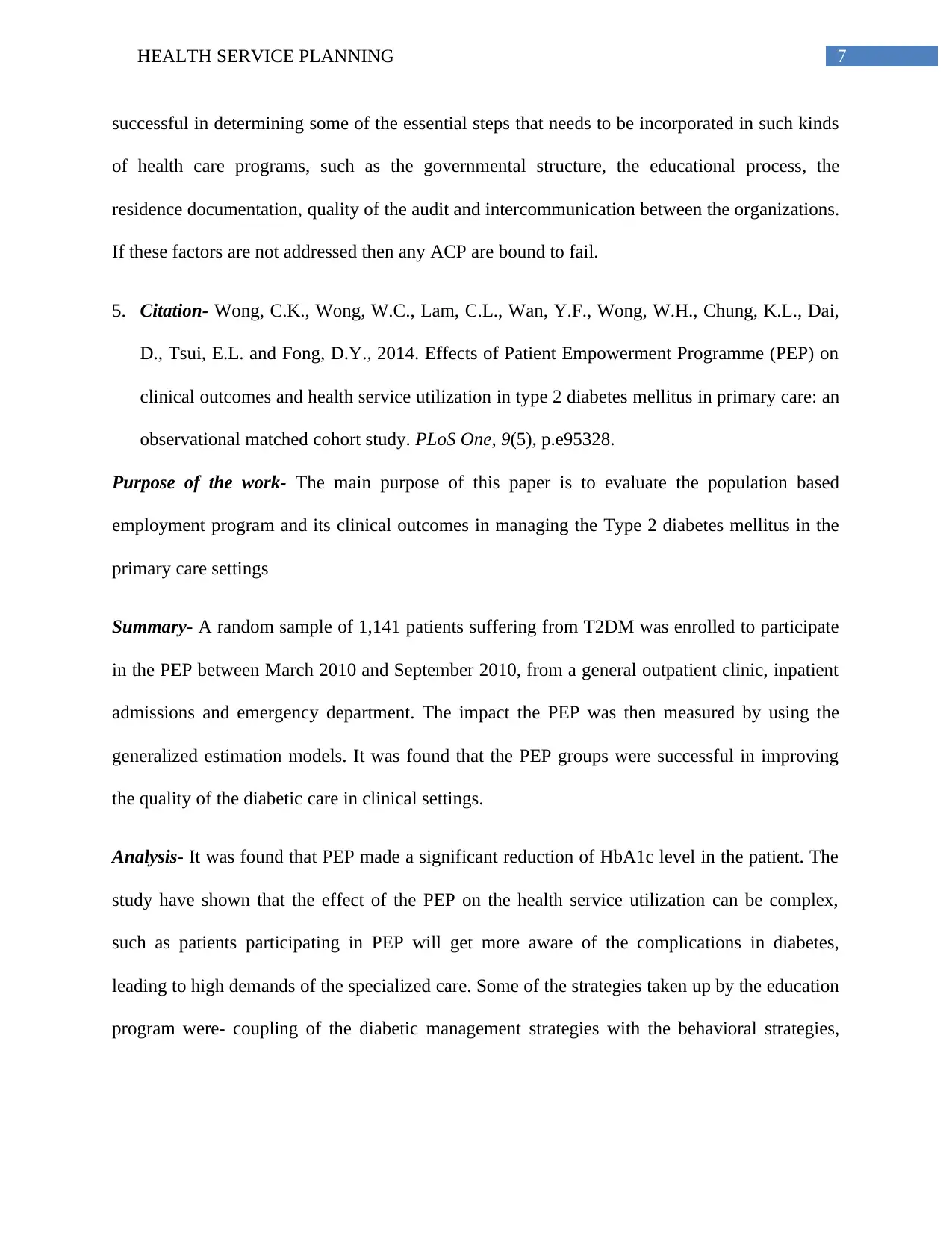
7HEALTH SERVICE PLANNING
successful in determining some of the essential steps that needs to be incorporated in such kinds
of health care programs, such as the governmental structure, the educational process, the
residence documentation, quality of the audit and intercommunication between the organizations.
If these factors are not addressed then any ACP are bound to fail.
5. Citation- Wong, C.K., Wong, W.C., Lam, C.L., Wan, Y.F., Wong, W.H., Chung, K.L., Dai,
D., Tsui, E.L. and Fong, D.Y., 2014. Effects of Patient Empowerment Programme (PEP) on
clinical outcomes and health service utilization in type 2 diabetes mellitus in primary care: an
observational matched cohort study. PLoS One, 9(5), p.e95328.
Purpose of the work- The main purpose of this paper is to evaluate the population based
employment program and its clinical outcomes in managing the Type 2 diabetes mellitus in the
primary care settings
Summary- A random sample of 1,141 patients suffering from T2DM was enrolled to participate
in the PEP between March 2010 and September 2010, from a general outpatient clinic, inpatient
admissions and emergency department. The impact the PEP was then measured by using the
generalized estimation models. It was found that the PEP groups were successful in improving
the quality of the diabetic care in clinical settings.
Analysis- It was found that PEP made a significant reduction of HbA1c level in the patient. The
study have shown that the effect of the PEP on the health service utilization can be complex,
such as patients participating in PEP will get more aware of the complications in diabetes,
leading to high demands of the specialized care. Some of the strategies taken up by the education
program were- coupling of the diabetic management strategies with the behavioral strategies,
successful in determining some of the essential steps that needs to be incorporated in such kinds
of health care programs, such as the governmental structure, the educational process, the
residence documentation, quality of the audit and intercommunication between the organizations.
If these factors are not addressed then any ACP are bound to fail.
5. Citation- Wong, C.K., Wong, W.C., Lam, C.L., Wan, Y.F., Wong, W.H., Chung, K.L., Dai,
D., Tsui, E.L. and Fong, D.Y., 2014. Effects of Patient Empowerment Programme (PEP) on
clinical outcomes and health service utilization in type 2 diabetes mellitus in primary care: an
observational matched cohort study. PLoS One, 9(5), p.e95328.
Purpose of the work- The main purpose of this paper is to evaluate the population based
employment program and its clinical outcomes in managing the Type 2 diabetes mellitus in the
primary care settings
Summary- A random sample of 1,141 patients suffering from T2DM was enrolled to participate
in the PEP between March 2010 and September 2010, from a general outpatient clinic, inpatient
admissions and emergency department. The impact the PEP was then measured by using the
generalized estimation models. It was found that the PEP groups were successful in improving
the quality of the diabetic care in clinical settings.
Analysis- It was found that PEP made a significant reduction of HbA1c level in the patient. The
study have shown that the effect of the PEP on the health service utilization can be complex,
such as patients participating in PEP will get more aware of the complications in diabetes,
leading to high demands of the specialized care. Some of the strategies taken up by the education
program were- coupling of the diabetic management strategies with the behavioral strategies,

8HEALTH SERVICE PLANNING
addressing the social, medical and the emotional requirements of the patient. PEP improved the,
LDL-C control although much benefit in the control of the blood pressure was not found.
The implication of this study is that ha study could identify the impact of the PEP in the
real world setting. The strength of the study is that a large number of participants were involved
in the study. PEP program could prove that it is possible to integrate NGO services in the
community for providing a community based care to the individual.
The limitations of this study are that the patient who participated in the study might be those
people who were motivated from the beginning in seeking the support. Secondly some of the
participants might have been receiving the co interventions like the multi0disciplinary risk
assessment and management program. Thirdly the controls may not match with all the potential
confounders.
6. Citation- Haby, M.M., Vos, T., Carter, R., Moodie, M., Markwick, A., Magnus, A., Tay-
Teo, K.S. and Swinburn, B., 2006. A new approach to assessing the health benefit from obesity
interventions in children and adolescents: the assessing cost-effectiveness in obesity project.
International journal of obesity, 30(10), p.1463.
Purpose of the work- This report is to understand the effectiveness of a new modeling approach
to assess the cost effectiveness of the obesity project and its implication in the obesity prevention
interventions in adolescents and children.
Summary- Nontraditional epidemiological study designs were taken for determining the health
benefits of the obesity project n the body mass index, the disability adjusted life years. Different
health benefits were considered but the greatest health benefit that was identified was likely to be
addressing the social, medical and the emotional requirements of the patient. PEP improved the,
LDL-C control although much benefit in the control of the blood pressure was not found.
The implication of this study is that ha study could identify the impact of the PEP in the
real world setting. The strength of the study is that a large number of participants were involved
in the study. PEP program could prove that it is possible to integrate NGO services in the
community for providing a community based care to the individual.
The limitations of this study are that the patient who participated in the study might be those
people who were motivated from the beginning in seeking the support. Secondly some of the
participants might have been receiving the co interventions like the multi0disciplinary risk
assessment and management program. Thirdly the controls may not match with all the potential
confounders.
6. Citation- Haby, M.M., Vos, T., Carter, R., Moodie, M., Markwick, A., Magnus, A., Tay-
Teo, K.S. and Swinburn, B., 2006. A new approach to assessing the health benefit from obesity
interventions in children and adolescents: the assessing cost-effectiveness in obesity project.
International journal of obesity, 30(10), p.1463.
Purpose of the work- This report is to understand the effectiveness of a new modeling approach
to assess the cost effectiveness of the obesity project and its implication in the obesity prevention
interventions in adolescents and children.
Summary- Nontraditional epidemiological study designs were taken for determining the health
benefits of the obesity project n the body mass index, the disability adjusted life years. Different
health benefits were considered but the greatest health benefit that was identified was likely to be
⊘ This is a preview!⊘
Do you want full access?
Subscribe today to unlock all pages.

Trusted by 1+ million students worldwide
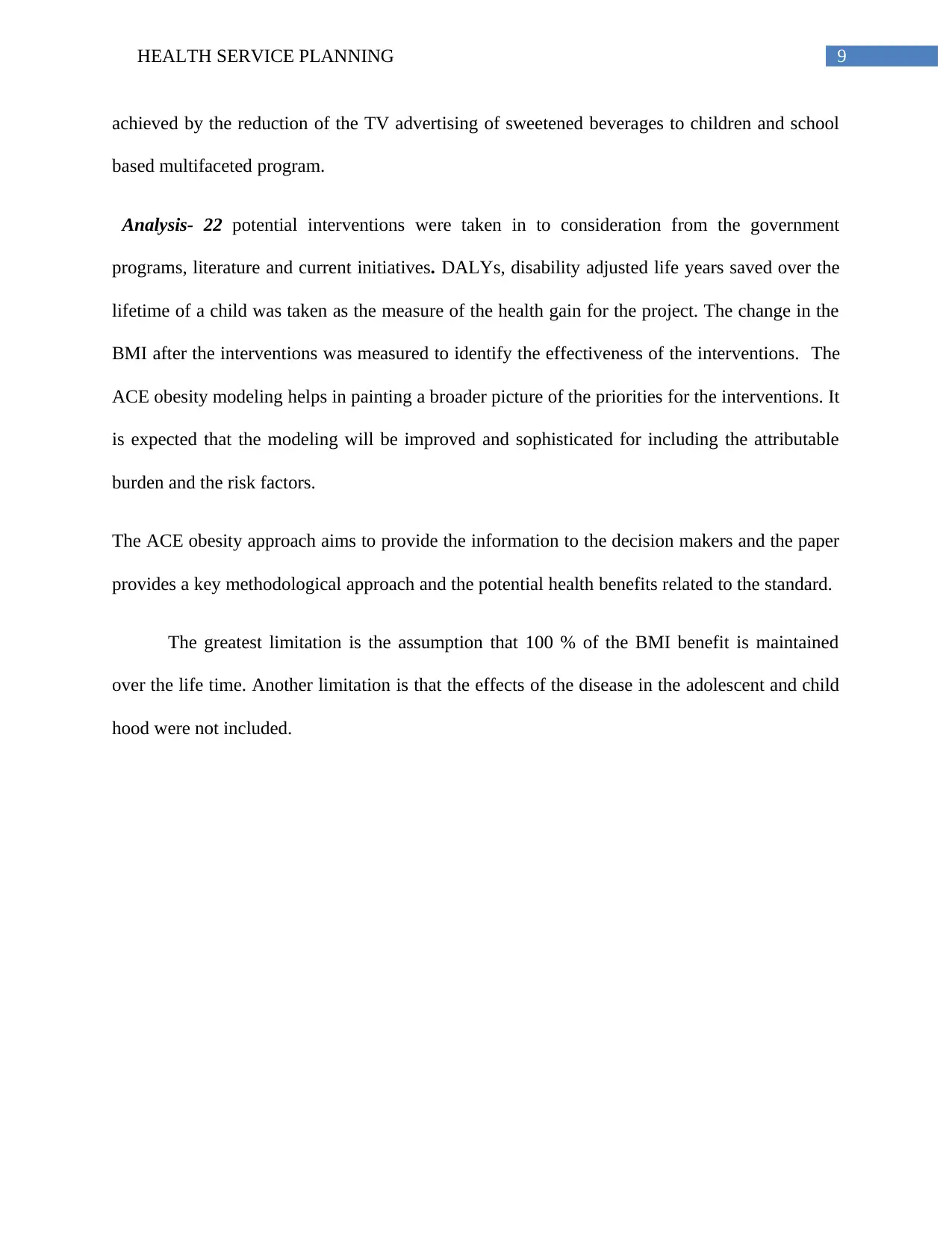
9HEALTH SERVICE PLANNING
achieved by the reduction of the TV advertising of sweetened beverages to children and school
based multifaceted program.
Analysis- 22 potential interventions were taken in to consideration from the government
programs, literature and current initiatives. DALYs, disability adjusted life years saved over the
lifetime of a child was taken as the measure of the health gain for the project. The change in the
BMI after the interventions was measured to identify the effectiveness of the interventions. The
ACE obesity modeling helps in painting a broader picture of the priorities for the interventions. It
is expected that the modeling will be improved and sophisticated for including the attributable
burden and the risk factors.
The ACE obesity approach aims to provide the information to the decision makers and the paper
provides a key methodological approach and the potential health benefits related to the standard.
The greatest limitation is the assumption that 100 % of the BMI benefit is maintained
over the life time. Another limitation is that the effects of the disease in the adolescent and child
hood were not included.
achieved by the reduction of the TV advertising of sweetened beverages to children and school
based multifaceted program.
Analysis- 22 potential interventions were taken in to consideration from the government
programs, literature and current initiatives. DALYs, disability adjusted life years saved over the
lifetime of a child was taken as the measure of the health gain for the project. The change in the
BMI after the interventions was measured to identify the effectiveness of the interventions. The
ACE obesity modeling helps in painting a broader picture of the priorities for the interventions. It
is expected that the modeling will be improved and sophisticated for including the attributable
burden and the risk factors.
The ACE obesity approach aims to provide the information to the decision makers and the paper
provides a key methodological approach and the potential health benefits related to the standard.
The greatest limitation is the assumption that 100 % of the BMI benefit is maintained
over the life time. Another limitation is that the effects of the disease in the adolescent and child
hood were not included.
Paraphrase This Document
Need a fresh take? Get an instant paraphrase of this document with our AI Paraphraser

10HEALTH SERVICE PLANNING
References
Blackford, J., Strickland, E. and Morris, B., 2007. Advance care planning in residential aged care
facilities. Contemporary Nurse, 27(1), pp.141-151.
Cohen, E., Jovcevska, V., Kuo, D.Z. and Mahant, S., 2011. Hospital-based comprehensive care
programs for children with special health care needs: a systematic review. Archives of pediatrics
& adolescent medicine, 165(6), pp.554-561.
Haby, M.M., Vos, T., Carter, R., Moodie, M., Markwick, A., Magnus, A., Tay-Teo, K.S. and
Swinburn, B., 2006. A new approach to assessing the health benefit from obesity interventions in
children and adolescents: the assessing cost-effectiveness in obesity project. International
journal of obesity, 30(10), p.1463.
Hoy, W.E., Davey, R.L., Sharma, S., Hoy, P.W., Smith, J.M. and Kondalsamy‐Chennakesavan,
S., 2010. Chronic disease profiles in remote Aboriginal settings and implications for health
services planning. Australian and New Zealand journal of public health, 34(1), pp.11-18.
Thomas, S.L., Wakerman, J. and Humphreys, J.S., 2015. Ensuring equity of access to primary
health care in rural and remote Australia-what core services should be locally available?.
International journal for equity in health, 14(1), p.111.
Wong, C.K., Wong, W.C., Lam, C.L., Wan, Y.F., Wong, W.H., Chung, K.L., Dai, D., Tsui, E.L.
and Fong, D.Y., 2014. Effects of Patient Empowerment Programme (PEP) on clinical outcomes
and health service utilization in type 2 diabetes mellitus in primary care: an observational
matched cohort study. PLoS One, 9(5), p.e95328.
References
Blackford, J., Strickland, E. and Morris, B., 2007. Advance care planning in residential aged care
facilities. Contemporary Nurse, 27(1), pp.141-151.
Cohen, E., Jovcevska, V., Kuo, D.Z. and Mahant, S., 2011. Hospital-based comprehensive care
programs for children with special health care needs: a systematic review. Archives of pediatrics
& adolescent medicine, 165(6), pp.554-561.
Haby, M.M., Vos, T., Carter, R., Moodie, M., Markwick, A., Magnus, A., Tay-Teo, K.S. and
Swinburn, B., 2006. A new approach to assessing the health benefit from obesity interventions in
children and adolescents: the assessing cost-effectiveness in obesity project. International
journal of obesity, 30(10), p.1463.
Hoy, W.E., Davey, R.L., Sharma, S., Hoy, P.W., Smith, J.M. and Kondalsamy‐Chennakesavan,
S., 2010. Chronic disease profiles in remote Aboriginal settings and implications for health
services planning. Australian and New Zealand journal of public health, 34(1), pp.11-18.
Thomas, S.L., Wakerman, J. and Humphreys, J.S., 2015. Ensuring equity of access to primary
health care in rural and remote Australia-what core services should be locally available?.
International journal for equity in health, 14(1), p.111.
Wong, C.K., Wong, W.C., Lam, C.L., Wan, Y.F., Wong, W.H., Chung, K.L., Dai, D., Tsui, E.L.
and Fong, D.Y., 2014. Effects of Patient Empowerment Programme (PEP) on clinical outcomes
and health service utilization in type 2 diabetes mellitus in primary care: an observational
matched cohort study. PLoS One, 9(5), p.e95328.
1 out of 11
Related Documents
Your All-in-One AI-Powered Toolkit for Academic Success.
+13062052269
info@desklib.com
Available 24*7 on WhatsApp / Email
![[object Object]](/_next/static/media/star-bottom.7253800d.svg)
Unlock your academic potential
Copyright © 2020–2025 A2Z Services. All Rights Reserved. Developed and managed by ZUCOL.





